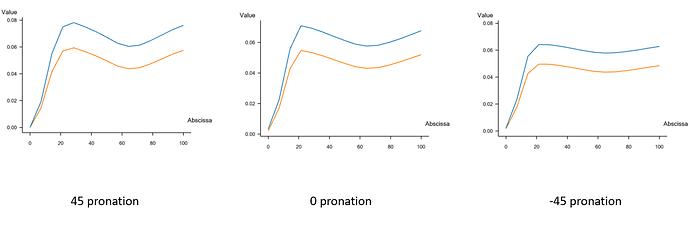Hi,
Thanks for the response.
Sorry for not being clear about my query.
I have close to seven readings in the elbow flexion and pronation readings for trial purpose. I am using the free posture moving model. The following are those values for elbow flexion and pronation, No other joint is been used in this simulation except elbow flexion and pronation.
AnyVector ElbowFlexionTime=.TimeSerie;
AnyVector ElbowFlexion ={0.0,30,60,90,120,90,60};
AnyVector ElbowPronationTime=.TimeSerie;
AnyVector ElbowPronation ={ 0,-20,-45,0,20,45,20};
There are no weight added to the body. It has just the body weight alone.
I want to know which muscle has done most work for this particular action. The following is the value in muscle activity for biceps and brachioradialis.
XY
Main.Study.Output.Model.HumanModel.Right.ShoulderArm.Mus.biceps_brachii_caput_longum.Activity
0.00 4.76e-003
0.17 5.20e-003
0.33 5.38e-003
0.50 5.24e-003
0.67 4.97e-003
0.83 5.34e-003
1.00 5.32e-003
XY
Main.Study.Output.Model.HumanModel.Right.ShoulderArm.Mus.Brach_rad_1.Activity
0.00 5.09e-005
0.17 5.02e-005
0.33 5.07e-005
0.50 4.93e-005
0.67 4.74e-005
0.83 4.96e-005
1.00 5.06e-005
Now, the following is the activity value for latissimus dorsi muscle. Now technically, this muscle should play no part in the elbow flexion and pronation.
Again, i have mentioned the values for the this muscle below.
XY
Main.Study.Output.Model.HumanModel.Right.ShoulderArm.Mus.latissimus_dorsi_3.Activity
0.00 2.77e-002
0.17 2.73e-002
0.33 2.69e-002
0.50 2.68e-002
0.67 2.69e-002
0.83 2.68e-002
1.00 2.70e-002
I am just using latissimus dorsi muscle as an example.
My question is why does a muscle like latissimus dorsi which does not help with elbow flexion or pronation have a higher activity than biceps and brachioradialis which actually contributes for the elbow flexion or pronation.
Even the muscle such as pronator teres which is primarily responsible for pronation has lesser activity.
XY
Main.Study.Output.Model.HumanModel.Right.ShoulderArm.Mus.Pronator_teres_caput_ulnare_1.Activity
0.00 5.09e-005
0.17 5.02e-005
0.33 5.07e-005
0.50 4.93e-005
0.67 4.74e-005
0.83 4.96e-005
1.00 5.06e-005
Why does this happen? And how to overcome this?
My next question is about no change in activity values with change in elbow pronation value. The elbow flexion value remains the same as mentioned above. The new pronation value is
AnyVector ElbowPronation ={ 0,-45,-45,-45,-45,-45,-45};
The brachioradilais activity value is as follows:
XY
Main.Study.Output.Model.HumanModel.Right.ShoulderArm.Mus.Brach_rad_1.Activity
0.00 5.11e-005
0.17 5.00e-005
0.33 5.08e-005
0.50 4.94e-005
0.67 4.73e-005
0.83 4.94e-005
1.00 5.08e-005
Now, i am changing the elbow pronation value alone.
AnyVector ElbowPronation ={ 0,0,0,0,0,0,0};
The brachioradialis value for this pronation angle is
XY
Main.Study.Output.Model.HumanModel.Right.ShoulderArm.Mus.Brach_rad_1.Activity
0.00 5.09e-005
0.17 4.99e-005
0.33 5.08e-005
0.50 4.94e-005
0.67 4.73e-005
0.83 4.94e-005
1.00 5.08e-005
As we can see, there is no change in muscle activity as the pronation angle changes. The same goes for biceps as well. Why does this happen?
My research requires me to find out the contribution of each muscle for a particular body motion. So, how do i use the activity to find that out or would you suggest something else ?
Please let me know.
Thank you.
